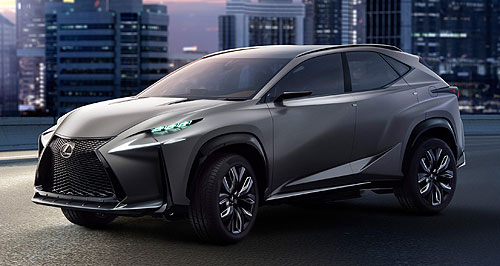Future models - Lexus - NXLexus ramps up for for turbo eraBattle-ready: The LF-NX concept earmarked for next week’s Tokyo motor show will feature a 2.0-litre turbocharged petrol engine –a stark contrast to the petrol-electric hybrid version unveiled at Frankfurt. Engineering tweaks cut turbo lag in Lexus LF-NX concept engine2 Dec 2013 By BARRY PARK in TOKYO LEXUS claims its world-first lag-reducing turbo technology that allows engines to wring out more power will eventually trickle down to Toyota-badged cars. The Japanese luxury brand unveiled its first-ever turbocharged engine at the Tokyo motor show, featuring under the bonnet of its LF-NX compact soft-roader concept. The 2.0-litre engine – no performance figures were given – features what Lexus claims is world-first technology that ports exhaust gases in such a way that there are no pressure losses in the turbocharger. According to Lexus, this has allowed Toyota’s luxury arm to strap on a turbocharger that is larger than what was possible using existing twin-scroll technology – and a performance boost. Teru Ogawa, the group manager of engine product design for Lexus, said the way the exhaust ports were cast – Lexus has produced the head with the inlet and exhaust manifolds cast as a single piece rather than bolted together – significantly reduced lag. Mr Ogawa said the key to the head’s design was that the exhaust ports did not allow pressure to leak to cylinders on the same half of the four-stroke cycle – a common problem in turbocharged engines and one of the main contributors to lag. “It’s been integrated in No.1 port and No.4 port – that has been united as one – and No.2 port and No.3 port,” Mr Ogawa said. “If you have just one like this (a traditional exhaust manifold), the other cylinder’s emissions pressure will interfere with the adjacent cylinder’s pressure. “In order that you don’t have that interference the opposing cylinders, No.1 and No.4, they do not interfere if you combine No.1 and No.4.” Mr Owaga said the turbocharger relied on exhaust gas pressure to turn it, so the loss of pressure to adjoining cylinders via the exhaust manifold would ensure they did not interfere with each other, reducing both performance and response. “If you reduce the turbo lag, when the customer presses the accelerator, the car responds right away,” he said. “When you’ve got that for turbo response, for the sake of response we don’t have to make the turbo smaller, which means that you can gain the maximum output. “We haven’t made it (the turbocharger) that big,” Mr Owaga said when asked how much larger a turbo was fitted to the engine. He said the turbo technology would roll out first in Lexus-badged products before tricking down to Toyota models. Lexus is a relative latecomer to the turbocharged party, with luxury rivals including Audi, BMW and Mercedes-Benz almost exclusively using boosted petrol engines featuring more expensive twin-scroll technology fitted. However, with the release of its first-ever turbocharged powerplant at Tokyo, Lexus now appears ready to embrace it. “Turbocharged is the next great thing and I don’t know if a lot of people have executed it as well as we want to,” Lexus global executive vice-president Mark Templin said at the recent Australian launch of the Lexus ES range. “Maybe we have been slower to the market than others but we are all about refinement, NVH (noise, vibration, harshness), smooth. “A lot of the turbocharged engines in the marketplace today aren’t so smooth, aren’t so refined. We think we can do it better.”  Read moreAll motor show Alfa Romeo Alfa Romeo Abarth Abarth Alpine Alpine Alpina Alpina Audi Audi Aston Martin Aston Martin BMW BMW Bentley Bentley Chery Chery Brabham Brabham Chrysler Chrysler Chevrolet Chevrolet Cupra Cupra Citroen Citroen DS DS Dodge Dodge Fiat Fiat Ferrari Ferrari Foton Foton Ford Ford Great Wall Great Wall FPV FPV Haval Haval GWM GWM Honda Honda Holden Holden Hummer Hummer HSV HSV Infiniti Infiniti Hyundai Hyundai Jaguar Jaguar Isuzu Isuzu Kia Kia Jeep Jeep Land Rover Land Rover Lamborghini Lamborghini Lexus Lexus LDV LDV Mahindra Mahindra Lotus Lotus Mazda Mazda Maserati Maserati Mercedes-AMG Mercedes-AMG McLaren McLaren MG MG Mercedes-Benz Mercedes-Benz Mitsubishi Mitsubishi Mini Mini Opel Opel Nissan Nissan Peugeot Peugeot Pagani Pagani Proton Proton Porsche Porsche Renault Renault Ram Ram Rover Rover Rolls-Royce Rolls-Royce Skoda Skoda Saab Saab SsangYong SsangYong Smart Smart Suzuki Suzuki Subaru Subaru Toyota Toyota Tesla Tesla Volvo VolvoMotor industry news |
Click to shareAll motor show Alfa Romeo Alfa Romeo Abarth Abarth Alpine Alpine Alpina Alpina Audi Audi Aston Martin Aston Martin BMW BMW Bentley Bentley Chery Chery Brabham Brabham Chrysler Chrysler Chevrolet Chevrolet Cupra Cupra Citroen Citroen DS DS Dodge Dodge Fiat Fiat Ferrari Ferrari Foton Foton Ford Ford Great Wall Great Wall FPV FPV Haval Haval GWM GWM Honda Honda Holden Holden Hummer Hummer HSV HSV Infiniti Infiniti Hyundai Hyundai Jaguar Jaguar Isuzu Isuzu Kia Kia Jeep Jeep Land Rover Land Rover Lamborghini Lamborghini Lexus Lexus LDV LDV Mahindra Mahindra Lotus Lotus Mazda Mazda Maserati Maserati Mercedes-AMG Mercedes-AMG McLaren McLaren MG MG Mercedes-Benz Mercedes-Benz Mitsubishi Mitsubishi Mini Mini Opel Opel Nissan Nissan Peugeot Peugeot Pagani Pagani Proton Proton Porsche Porsche Renault Renault Ram Ram Rover Rover Rolls-Royce Rolls-Royce Skoda Skoda Saab Saab SsangYong SsangYong Smart Smart Suzuki Suzuki Subaru Subaru Toyota Toyota Tesla Tesla Volvo VolvoMotor industry news |






















Facebook Twitter Instagram